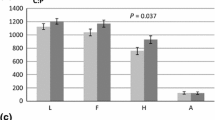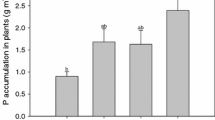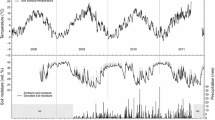Abstract
Global emissions of atmospheric CO2 and tropospheric O3 are rising and expected to impact large areas of the Earth’s forests. While CO2 stimulates net primary production, O3 reduces photosynthesis, altering plant C allocation and reducing ecosystem C storage. The effects of multiple air pollutants can alter belowground C allocation, leading to changes in the partial pressure of CO2 (pCO2) in the soil , chemistry of dissolved inorganic carbonate (DIC) and the rate of mineral weathering. As this system represents a linkage between the long- and short-term C cycles and sequestration of atmospheric CO2, changes in atmospheric chemistry that affect net primary production may alter the fate of C in these ecosystems. To date, little is known about the combined effects of elevated CO2 and O3 on the inorganic C cycle in forest systems. Free air CO2 and O3 enrichment (FACE) technology was used at the Aspen FACE project in Rhinelander, Wisconsin to understand how elevated atmospheric CO2 and O3 interact to alter pCO2 and DIC concentrations in the soil. Ambient and elevated CO2 levels were 360±16 and 542±81 μl l−1, respectively; ambient and elevated O3 levels were 33±14 and 49±24 nl l−1, respectively. Measured concentrations of soil CO2 and calculated concentrations of DIC increased over the growing season by 14 and 22%, respectively, under elevated atmospheric CO2 and were unaffected by elevated tropospheric O3. The increased concentration of DIC altered inorganic carbonate chemistry by increasing system total alkalinity by 210%, likely due to enhanced chemical weathering. The study also demonstrated the close coupling between the seasonal δ13C of soil pCO2 and DIC, as a mixing model showed that new atmospheric CO2 accounted for approximately 90% of the C leaving the system as DIC. This study illustrates the potential of using stable isotopic techniques and FACE technology to examine long- and short-term ecosystem C sequestration.



Similar content being viewed by others
References
Amiotte-Suchet P, Aubert D, Probst JL, Gauthier-Lafaye F, Probst A, Andreux F, Viville D (1999) δ13C pattern of dissolved inorganic carbon in a small granitic catchment: the (2000) Strengbach case study (Vosges mountains, France). Chem Geol 159:129–145
Andrews JA, Schlesinger WH (2001) Soil CO2 dynamics, acidification, and chemical weathering in a temperate forest with experimental CO2 enrichment. Glob Biogeochem Cycles 15(1):149–162
Atekwana EA, Krishnamurthy RV (1998) Seasonal variations of dissolved inorganic carbon and d13C of surface waters: application of a modified gas evolution technique. J Hydrol 205:265–278
Berg A, Banwart SA (2000) Carbon dioxide mediated dissolution of Ca-feldspar: implications for silicate weathering. Chem Geol 163:25–42
Berner RA (1997) The rise of plants and their effect on weathering and atmospheric CO2. Science 276:544–546
Berthelin J (1988) Microbial weathering processes in natural environments. In: Lerman A, Meybeck M (eds) Physical and chemical weathering in geochemical cycles. Kluwer, Dordrecht, pp 33–59
Bormann BT, Wang D, Bormann FH, Benoit G, April R, Snyder R (1998) Rapid, plant-induced weathering in an aggrading experimental ecosystem. Biogeochemistry 43:129–155
Chameides WL, Kasibhatla PS, Yienger J, Levy H II (1994) Growth of continental-scale, metro-agro-plexes, regional ozone pollution, and world food production. Science 264:74–77
Chappelka AH, Samuelson LJ (1998) Ambient ozone effects on forest trees in the Eastern United States: a review. New Phytol 139:91–108
Clark ID, Fritz P (1997) Environmental isotopes in hydrogeology. CRC, New York
Coleman MD, Isebrands JG, Dickson RE, Karnosky DF (1995) Photosynthetic productivity of aspen clones varying in sensitivity to tropospheric ozone. Tree Physiol 15:585–592
DeLucia EH, Hamilton JG, Naidu SL, Thomas RB, Andrews JA, Finzi A, Lavine M, Matamala R, Mohan JE, Hendrey GR, Schlesinger WH (1999) Net primary production of a forest ecosystem with experimental CO2 enrichment. Science 289:1177–1179
Dickson RE, Lewin KF, Isebrands JG, Coleman MD, Heilman WE, Riemenschneider DE, Sober J, Host GE, Zak DR, Hendrey GR, Pregitzer KS, Karnosky DF (2000) Forest atmosphere carbon transfer and storage (FACTS-II). The aspen free-air CO2 and O3 enrichment (FACE) project: an overview. USDA Forest Service. General Technical Report NC—214
Drever JI (1994) The effect of land plants on weathering rates of silicate minerals. Geochim Cosmochim Acta 58(10):2325–2332
Fowler D, Cape JN, Coyle M, Flechard C, Kuylenstierna J, Hicks K, Derwent D, Johnson C, Stevenson D (1999) The global exposure of forests to air pollutants. Water Air Soil Pollut 116:5–32
Garrells RM, Christ CL (1965) Solutions, minerals, and equilibria. Harper-Collins, New York
Houghton RA (2003) Why are estimates of the terrestrial carbon balance so different? Global Change Biol 9:500–509
Houghton JT, Meira Filho LG, Callander BA, Harris N, Kattenberg A, Maskell K (1996) Climate change 1995: the science of climate change Cambridge University Press, Cambridge
Karnosky DF, Gagnon ZE, Dickson RE, Coleman MD, Lee EH, Isebrands JG (1996) Changes in leaf growth, leaf abscission, and biomass associated with seasonal tropospheric ozone exposures of Populus tremuloides clones and seedlings. Can J For Res 26:23–37
Kendall C, McDonnel JJ (1998) Isotope tracers in catchment hydrology. Elsevier, New York
King JS, Pregitzer KS, Zak DR, Sober J, Isebrands JG, Dickson RE, Hendrey GR, Karnsoky DF (2001) Fine-root biomass and fluxes of carbon in young stands of paper birch and trembling aspen as affected by elevated atmospheric CO2 and tropospheric O3. Oecologia 128:237–250
Kubiske ME, Pregitzer KS, Zak DR, Mikan CJ (1998) Growth and C allocation of Populus tremuloides genotypes in response to atmospheric CO2 and soil N availability. New Phytol 140:251–260
Lackner KS (2002) Carbonate chemistry for sequestering fossil carbon. Annu Rev Energy Environ 27:193–232
Landry LG, Pell EJ (1993) Modification of Rubisco and altered proteolytic activity in O3-stressed hybrid poplar (Populus maximowizii × trichocarpa). Plant Physiol 101:1355–1362
Loya WM, Pregitzer KS, Karberg NJ, King JS, Giardina CP (2003) Reduction of soil carbon formation by tropospheric ozone under increased carbon dioxide levels. Nature 425:705–707
Marenco A, Gouget H, Nedelec P, Pages JP, Karcher F (1994) Evidence of a long-term increase in tropospheric ozone from Pic du Midi series: consequences: positive radiative forcing. J Geophys Res 99(D8):16617–16632
Matamala R, Schlesinger WH (2000) Effects of elevated atmospheric CO2 on fine root production and activity in a temperate forest ecosystem. Global Change Biol 6:967–980
Middleton K, Coniglio M, Frape SK (1990) Burial dedolomitization, Middle Ordivician carbonates, southwestern Ontario. AAPG Bull 74:1308
Pankow JF (1991) Aquatic chemistry concepts. Lewis, Chelsea
Pell EJ (1987) Ozone toxicity-is there more than one mechanism of action? In: Hutchinson TC, Meema KM (eds) Effects of atmospheric pollutants on forests, wetlands, and agricultural ecosystems. (NATO ASI series, vol G16) Springer, Berlin Heidelberg New York, pp 229–240
Phillips RL, Zak DR, Holmes WE, White DC (2002) Microbial community composition and function beneath temperate trees exposed to elevated atmospheric carbon dioxide and ozone. Oecologia 131:236–244
Pregitzer KS, Zak DR, Curtis PS, Kubiske ME, Teeri JA, Vogel CS (1995) Atmospheric CO2, soil nitrogen, and turnover of fine roots. New Phytol 129:579–585
Pregitzer KS, Zak DR, Masiaz J, DeForest J, Curtis PS, Lussenhop J (2000) Interactive effects of atmospheric CO2 and soil-N availability on the fine roots of Populus tremuloides. Ecol Appl 10:18–33
Reich PB, Ellsworth DS, Kloeppel BD, Fownes JH, Gower ST (1990) Vertical variation in canopy structure and CO2 exchange of oak-maple forests influence of ozone, nitrogen, and other factors on simulated canopy carbon gain. Tree Physiol 7:329–345
Sage RF (1994) Acclimation of photosynthesis to increasing atmospheric CO2: the gas exchange perspective. Photosynth Res 39:351–368
Schimel DS (1995) Terrestional ecosystems and the carbon cycle. Global Change Biol 1:77–91
Schlesinger WH (1997) Biogeochemistry: an analysis of global change. Academic Press, New York
Stumm W, Morgan JJ (1981) Aquatic chemistry. Wiley, New York
Suarez DL (1987) Prediction of pH errors in soil-water extractors due to degassing. Soil Sci Soc Am J 51:64–67
Taylor TR, Sibley DF (1986) Ferroan dolomite in the Trenton formation, Ordovician Michigan Basin. Sedimentology 33:61–86
Tolbert NE, Zelitch I (1983) Carbon metabolism. In: Lemon ER (eds) CO2 in plants. Westview, Boulder, Colo., pp 71–88
Tu KP, Brooks PD, Dawson TE (2001) Using septum-capped vials with continuous flow isotope ratio mass spectrometric analysis of atmospheric CO2 for Keeling plot applications. Rapid Commun Mass Spectrom 15
Zak DR, Pregitzer KS (1998) Integration of ecophysiological and biogeochemical approaches to ecosystem dynamics. In: Pace M, Groffman P (eds) Successes, limitations, and frontiers in ecosystem science. Springer, Berlin Heidelberg New York, pp 372–403
Zak DR, Pregitzer KS, King JS, Holmes WE (2000) Elevated atmospheric CO2, fine roots and the response of sol microorganisms: a review and hypothesis. New Phytol 147:201–222
Zhang J, Quay PD, Walbur DO (1994) Carbon isotope fractionation during gas-water exchange and dissolution of CO2. Geochim Cosmochim Acta 59:107–114
Acknowledgements
This study was aided by the help of numerous people: J. Taylor, E. Nauertz, R. Ketterer, W. Loya, M. Porter, R. Peryam, K. Larsen, J. Ashby, J. Eikenberry, and A. Johansen. This research was supported by the US Department of Energy’s Office of Science ( Program for Ecosystem Research and National Institute for Global Environmental Change), the USDA Forest Service (Northern Global Change Program and North Central Research Station), the National Science Foundation (DEB, DBI/MRI), and the USDA National Research Initiatives Competitive Grants Program. G. Hendrey, K. Lewin, J. Nagey, D. Karnsoky, and J. Sober have been instrumental in the successful implementation of this long-term study.
Author information
Authors and Affiliations
Corresponding author
Rights and permissions
About this article
Cite this article
Karberg, N.J., Pregitzer, K.S., King, J.S. et al. Soil carbon dioxide partial pressure and dissolved inorganic carbonate chemistry under elevated carbon dioxide and ozone. Oecologia 142, 296–306 (2005). https://doi.org/10.1007/s00442-004-1665-5
Received:
Accepted:
Published:
Issue Date:
DOI: https://doi.org/10.1007/s00442-004-1665-5




